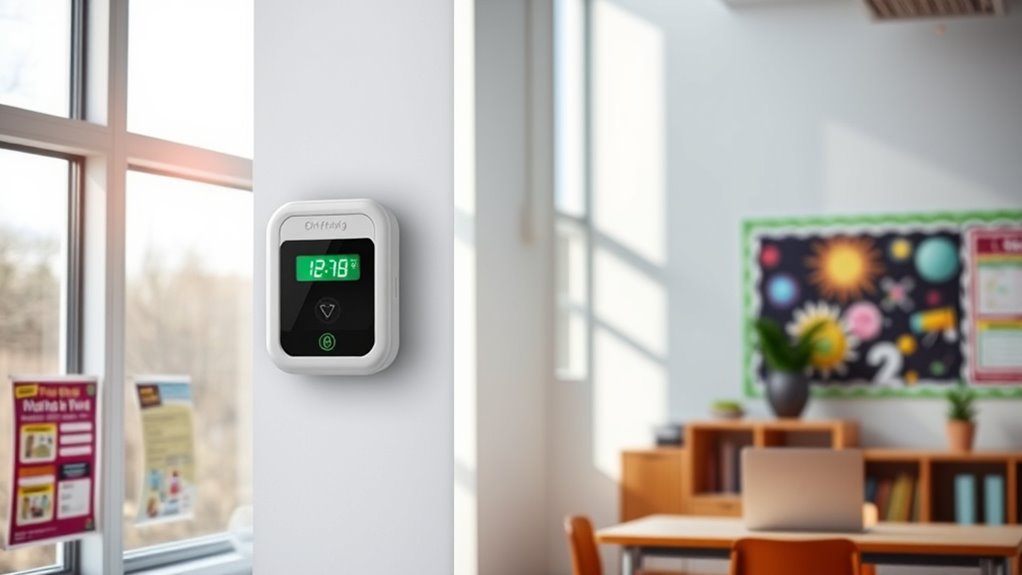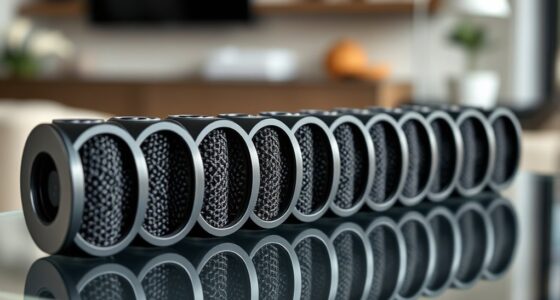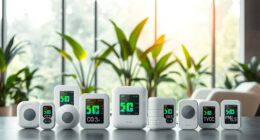I’ve found that the best combined CO₂ and VOC detectors for schools include multi-parameter monitors like the Air Quality Monitors and AQI Meter, which track CO₂, formaldehyde, TVOCs, and other pollutants in real time. Some offer advanced features like HD displays, alarms, and easy calibration, making them ideal for maintaining safe indoor environments. If you continue exploring, you’ll discover important factors to weigh when choosing the right device for your school.
Key Takeaways
- Multi-parameter monitors with real-time CO₂, VOC, PM, temperature, and humidity detection provide comprehensive indoor air quality assessment for schools.
- Devices feature visual, audible, and vibrating alarms to promptly alert staff and students of unsafe air conditions.
- User-friendly LCD displays and HD digital screens enable easy monitoring of pollution levels and hazard alerts.
- Compact, portable, and easy-to-install detectors support flexible placement across multiple school areas.
- Reliable sensors with automatic calibration and long battery life ensure continuous, accurate air quality monitoring in educational environments.
CO2 Detector Air Quality Monitor (White)
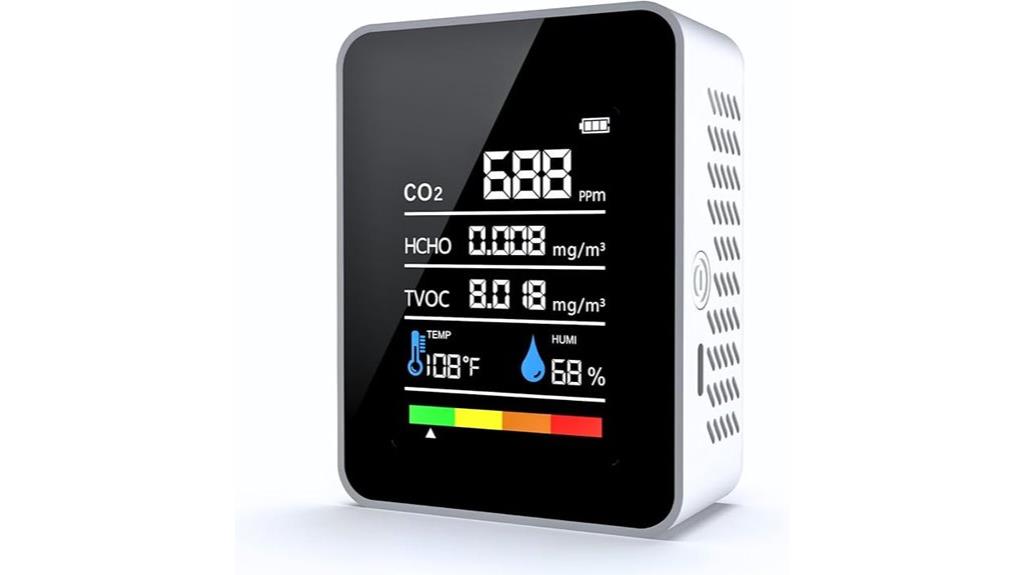
The CO2 Detector Air Quality Monitor (White) is an ideal choice for schools that need a versatile, easy-to-use device to monitor not just CO2 levels but also formaldehyde, TVOC, temperature, and humidity. Its compact, portable design makes it perfect for classrooms or common areas. The device features a clear 2.8 HD color screen with color-coded alerts and audible/vibrating alarms to warn of unsafe conditions. With a rechargeable battery lasting over 24 hours and simple USB-C charging, it offers convenience. While calibration and night-time brightness can be concerns, its multi-parameter monitoring helps maintain a healthier indoor environment, supporting better learning conditions.
Best For: schools, offices, and homes seeking a portable, multi-parameter air quality monitor to ensure a safe indoor environment with real-time alerts.
Pros:
- Measures multiple environmental parameters including CO2, formaldehyde, TVOC, temperature, and humidity in one device
- Portable design with over 24 hours of battery life and easy USB-C charging
- Clear color-coded display with audible and vibrating alarms for quick, intuitive alerts
Cons:
- Inconsistent or fluctuating CO2 readings and calibration difficulties reported by some users
- Bright LED screen can be too luminous at night with no option to turn off the display
- Battery life may require daily recharging, which can be inconvenient for continuous monitoring
Indoor Air Quality Monitor, AQI Meter

If you’re looking for an indoor air quality monitor that provides continuous, real-time data, this AQI meter is an excellent choice for schools. It tracks formaldehyde, PM1/PM2.5/PM10 particles, VOCs, humidity, and temperature around the clock. Using advanced laser-based sensors and electrochemical technology, it delivers accurate measurements of pollution sources like wildfires, fumes, and industrial emissions. The device features intelligent calibration and an alarm system that alerts you when air quality drops below safe levels. Its versatility makes it perfect for classrooms, offices, and other indoor spaces, helping guarantee a healthier environment for students and staff.
Best For: schools, offices, and indoor environments seeking continuous real-time air quality monitoring to ensure a healthy space for occupants.
Pros:
- Provides 24-hour real-time detection of formaldehyde, PM particles, VOCs, humidity, and temperature for comprehensive air quality assessment.
- Utilizes advanced laser sensors and electrochemical technology for highly accurate pollution source detection and measurement.
- Features intelligent calibration and hazard alarm systems that alert users promptly when air quality exceeds safe standards.
Cons:
- May require periodic calibration to maintain optimal accuracy over time.
- The device’s advanced features and sensors could result in a higher initial cost compared to basic air quality monitors.
- Requires a power source, limiting portability in some outdoor or remote locations.
Kidde Battery-Powered Carbon Monoxide Detector
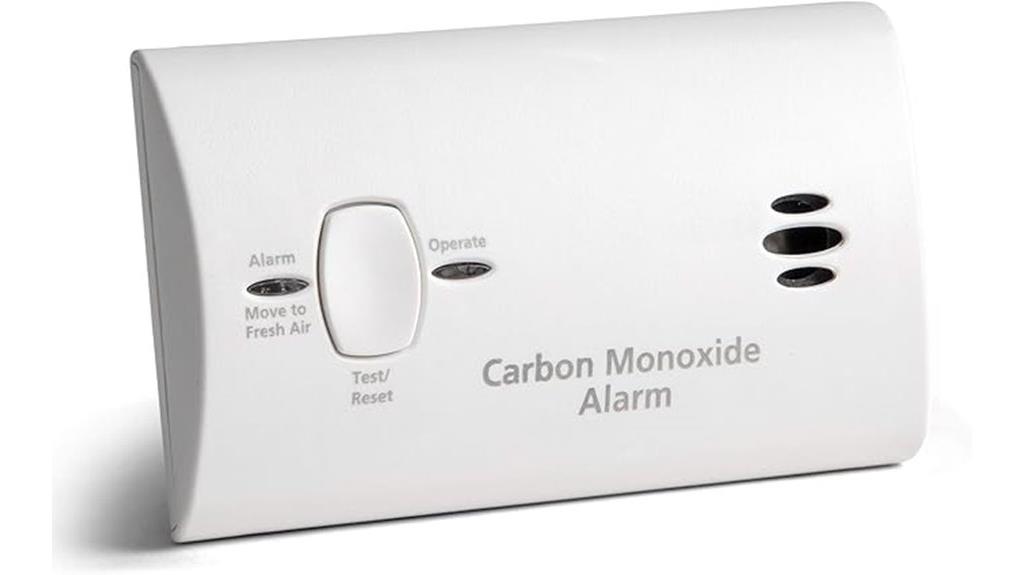
Kidde’s Battery-Powered Carbon Monoxide Detector stands out as an ideal choice for schools needing a reliable, portable CO alarm that requires no wiring. It’s easy to install on walls or tabletops, thanks to its battery operation with 2-AA batteries included. The detector uses electrochemical sensor technology for accurate CO detection, ensuring safety. It features an 85-decibel alarm to alert occupants, with green and red LEDs indicating power and CO levels. The unit also has event memory, so you can track last detections or tests. Its straightforward design makes it a practical, maintenance-friendly option for maintaining safe learning environments.
Best For: schools and educational environments seeking a reliable, portable, and easy-to-install carbon monoxide detector without wiring requirements.
Pros:
- Battery-powered with included 2-AA batteries ensures operation during power outages.
- Uses electrochemical sensor technology for accurate CO detection.
- Features event memory, LED indicators, and an audible alarm for comprehensive safety monitoring.
Cons:
- Requires regular battery replacement to maintain functionality.
- Limited to portable installation; not designed for permanent wired setups.
- May have limited detection range compared to more advanced or wired detectors.
First Alert Carbon Monoxide Detector (CO605, 1-Pack)
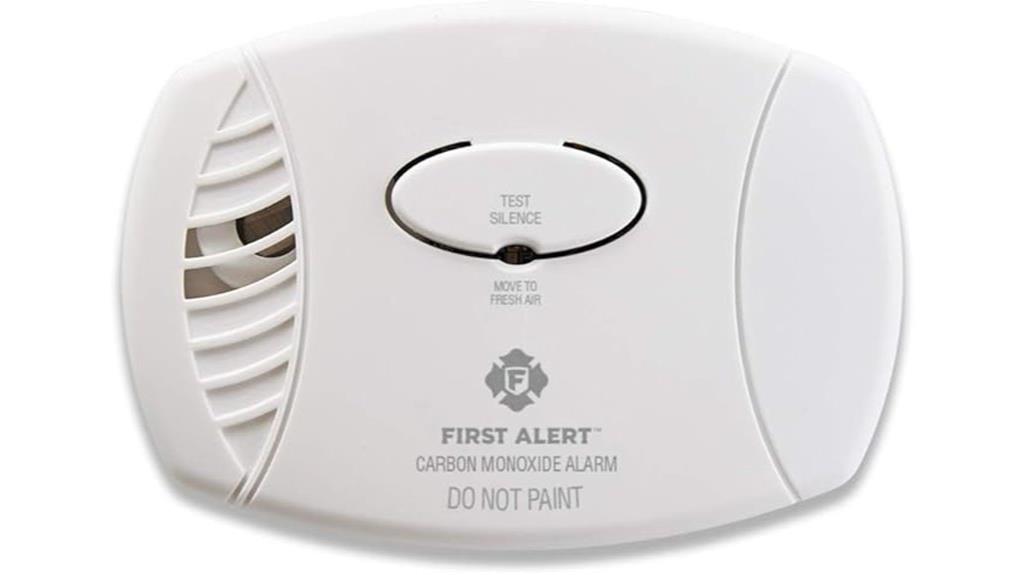
Designed with safety and ease of use in mind, the First Alert Carbon Monoxide Detector (CO605, 1-Pack) is an ideal choice for schools seeking reliable early warning. It’s a plug-in alarm with a battery backup, ensuring continuous protection even during outages. Its advanced electrochemical sensor accurately detects CO levels regardless of placement. The device features a single test/silence button for quick operation and an end-of-life signal to indicate when it needs replacing. With an 85-decibel alarm, it alerts staff immediately to dangerous conditions. Its compact design fits standard outlets, making installation simple and unobtrusive for any classroom or common area.
Best For: Schools and educational facilities seeking reliable, easy-to-use carbon monoxide detection to ensure safety in classrooms and common areas.
Pros:
- Accurate detection of CO levels with advanced electrochemical sensor
- Plug-in design with battery backup for continuous protection during outages
- Simple operation with single test/silence button and end-of-life indicator
Cons:
- Limited to standard outlets, potentially restricting placement options
- Only one unit recommended per level and bedroom for comprehensive coverage
- 7-year limited warranty may require replacement after this period
Air Quality Monitor with CO2, HCHO, TVOC, Temperature & Humidity
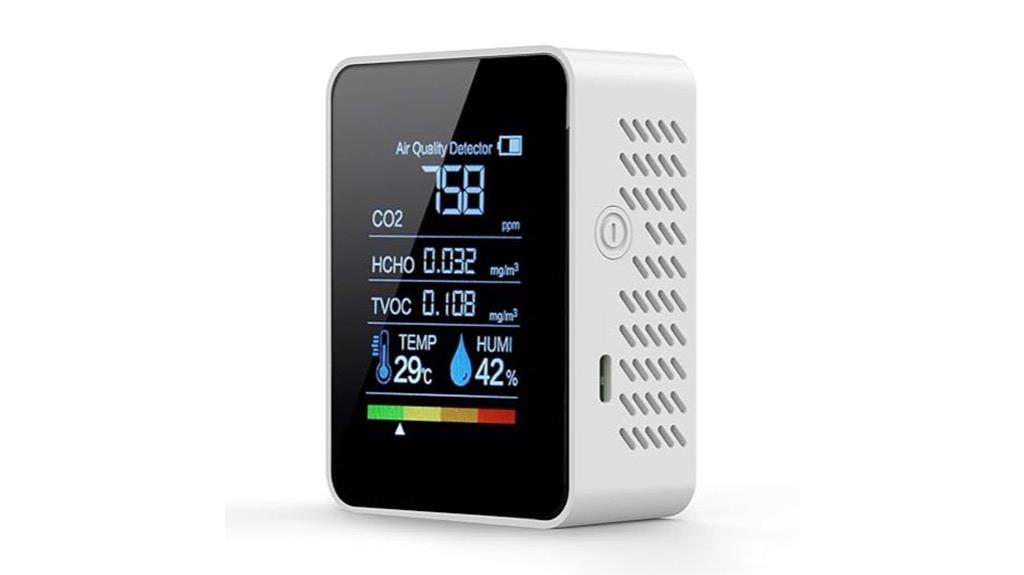
The Air Quality Monitor with CO2, HCHO, TVOC, Temperature, and Humidity stands out as an ideal choice for schools that need extensive, real-time indoor air quality data. It provides a thorough view of airborne pollutants and climate conditions with a clear, bright display and simple USB-C setup. Its compact, portable design allows easy placement across classrooms or common areas, with up to 20 hours of battery life. Equipped with advanced sensors, it delivers accurate measurements of CO2, formaldehyde, VOCs, temperature, and humidity. The device features alerts for poor air quality, helping staff respond promptly to maintain a healthy learning environment.
Best For: schools and educational institutions seeking comprehensive, real-time indoor air quality monitoring to ensure a healthy learning environment.
Pros:
- Provides accurate, real-time data on CO2, HCHO, TVOC, temperature, and humidity, enhancing indoor air quality management
- Compact, portable design with up to 20 hours of battery life allows flexible placement across multiple areas
- Easy to set up and operate with a clear, bright display and simple USB-C connection
Cons:
- Battery life may be shorter than advertised, with some users experiencing only a few hours of use
- Lack of app-based trend analysis or long-term data tracking limits monitoring capabilities over time
- External measurements like humidity and temperature may slightly differ from other trusted devices, affecting precise calibration
3 Packs Smoke and CO Alarm Combo (2-in-1)
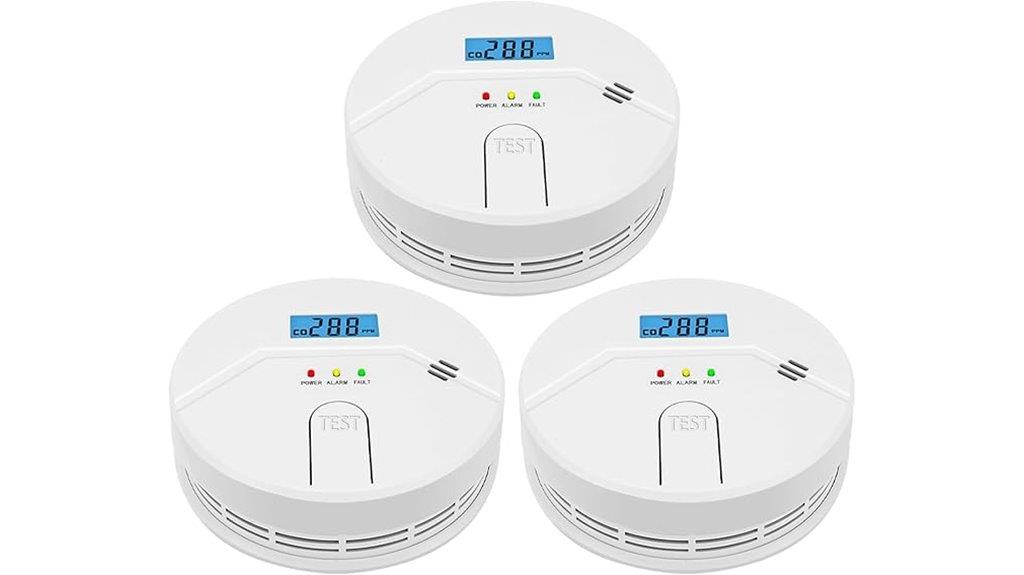
If you’re looking for an affordable, all-in-one solution to protect multiple areas, the Packs Smoke and CO Alarm Combo (2-in-1) is an excellent choice. It combines smoke and carbon monoxide detection in a single device, offering thorough safety. Equipped with two high-stability sensors, it detects dangers promptly and displays real-time concentration levels on an LCD screen. The device emits an 85 dB alarm when hazards are detected, alerting occupants immediately. Battery-powered with easy setup and maintenance, it’s perfect for continuous monitoring. Regular battery replacement ensures peak performance, and simple troubleshooting makes it user-friendly, providing reliable protection for school environments.
Best For: households, schools, or multi-room environments seeking an affordable, all-in-one smoke and carbon monoxide detection solution for comprehensive safety.
Pros:
- Combines smoke and CO detection in a single, space-saving device for enhanced safety.
- Equipped with two high-stability sensors and an LCD display for real-time monitoring and quick detection.
- Battery-powered with easy installation and straightforward maintenance, ideal for continuous protection.
Cons:
- Regular battery replacement is necessary to maintain optimal performance.
- False alarms may occur if smoke inlet obstructions are present, requiring troubleshooting.
- Limited to battery power; does not include a hardwired or interconnected system option.
2 Packs Carbon Monoxide Detectors with PPM Display
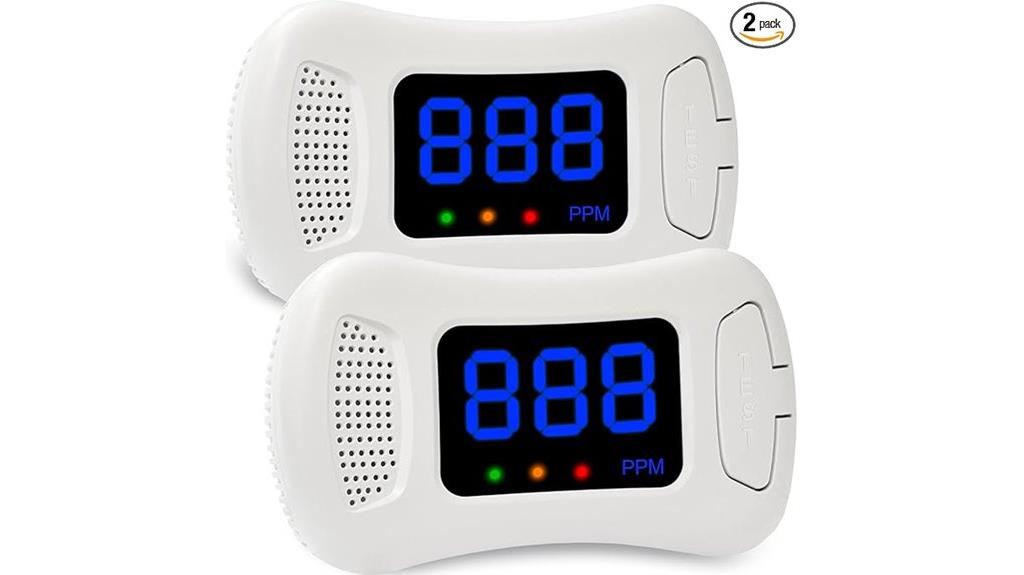
For those seeking reliable carbon monoxide detection, packs with PPM displays offer a clear advantage by providing real-time, precise readings of CO levels. These two-pack detectors are battery-operated, easy to install, and feature an intuitive interface with a clear PPM readout, ensuring quick awareness of CO presence. They respond swiftly to dangerous levels—alerting at 50ppm within 60-90 minutes, and even faster at higher concentrations. The loud 85-decibel alarm, combined with a flashing red LED, guarantees prompt alerts. Lightweight and portable, they’re perfect for various environments, offering peace of mind wherever safety is a priority.
Best For: individuals and families seeking reliable, portable CO detection solutions for home, travel, or outdoor activities.
Pros:
- Easy to install and operate with a simple test/reset button and battery-powered design.
- Real-time PPM display provides accurate, immediate readings for enhanced safety.
- Loud 85-decibel alarm with flashing LED ensures prompt notification of dangerous CO levels.
Cons:
- Batteries are not included, requiring additional purchase.
- Small size may limit visibility of the display in certain settings or for users with visual impairments.
- Some users have expressed concerns about the expiration date and long-term sensor calibration.
Portable Carbon Monoxide and Dioxide Detector with Magnetic Suction
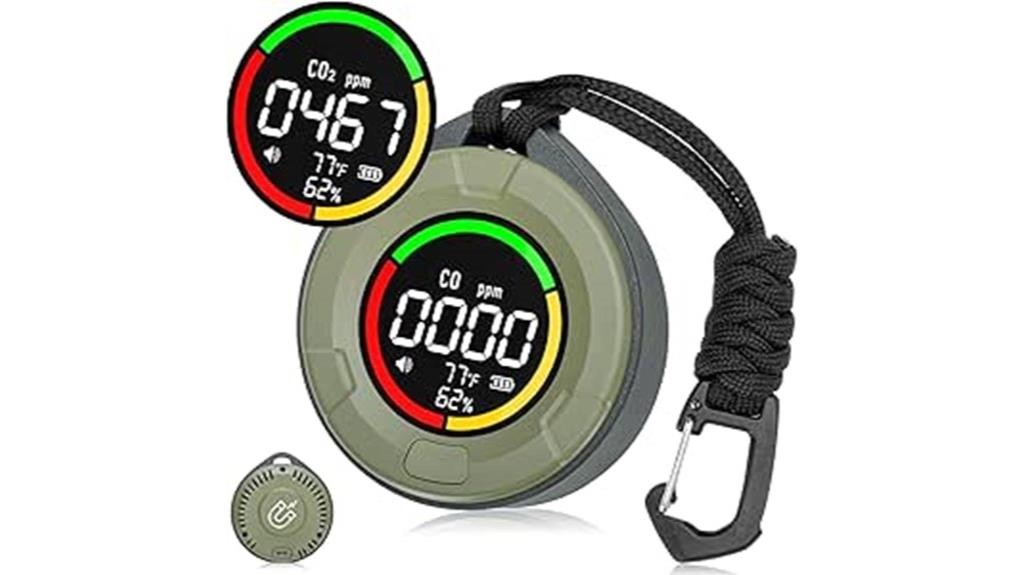
Portable Carbon Monoxide and Dioxide Detectors with magnetic suction are ideal for schools needing quick, reliable monitoring of indoor air quality. I find this device especially useful because it’s compact, lightweight, and versatile for both indoor and outdoor environments. Its magnetic back allows easy attachment to metal surfaces, while the built-in screen shows real-time readings of CO, CO₂, temperature, and humidity. With customizable alarms and visual alerts, it promptly warns of unsafe levels, ensuring safety. The rechargeable battery and fast USB-C charging make it convenient for daily use, and its durable design withstands impacts—perfect for busy school settings.
Best For: schools, travelers, campers, and indoor/outdoor users seeking reliable, portable air quality monitoring with customizable alerts.
Pros:
- Compact, lightweight, and easy to carry or attach to metal surfaces with magnetic suction
- Real-time monitoring of CO, CO₂, temperature, and humidity with visual and audible alerts
- Rechargeable battery with fast USB-C charging and durable, impact-resistant design
Cons:
- Single-button operation may be challenging for adjusting settings and thresholds
- Screen visibility can vary under different lighting conditions
- Some users have experienced charging issues or device malfunctions after initial use
5-in-1 Carbon Monoxide and Gas Detector
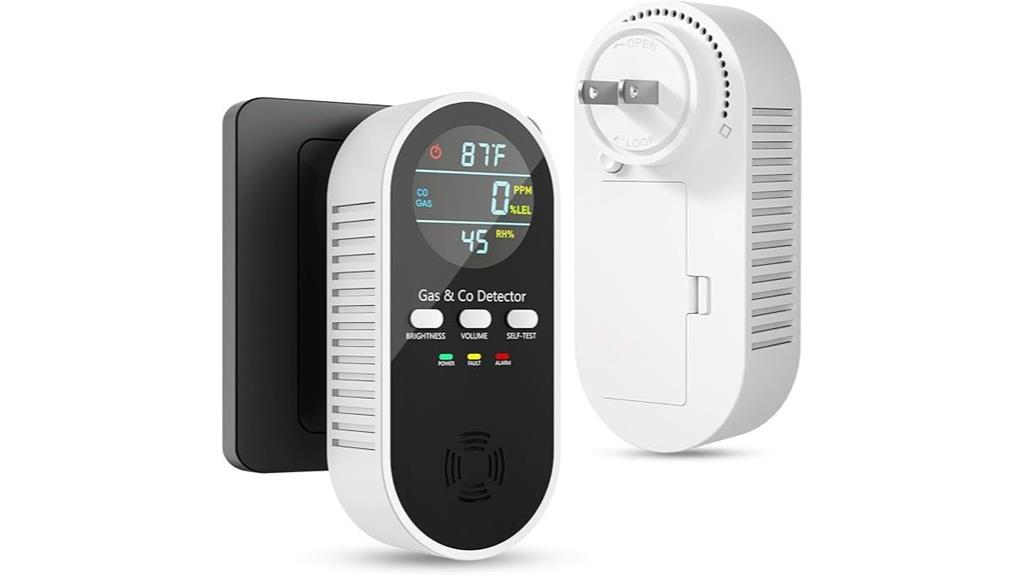
The 5-in-1 Carbon Monoxide and Gas Detector stands out as an ideal choice for schools that need all-encompassing environmental monitoring in one device. It detects carbon monoxide levels, combustible gases, temperature, and humidity in real-time, providing exhaustive safety data. Its plug-in design with a battery backup ensures continuous operation during power outages. The HD digital display makes it easy to read sensor data at a glance, while the adjustable 85-decibel alarm alerts staff immediately if dangerous levels are detected. With simple installation and a one-year return policy, this detector offers reliable, all-in-one protection to keep learning environments safe.
Best For: educational institutions and facilities seeking comprehensive, real-time environmental monitoring and safety with easy installation and reliable alerts.
Pros:
- Combines multiple detection functions (CO, gas, temperature, humidity) in one device for all-in-one safety.
- Plug-in design with battery backup ensures continuous protection even during power outages.
- HD digital display provides clear, instant access to sensor data and alarm status.
Cons:
- May require space near power outlets for optimal plug-in installation.
- The device’s size and display might be larger than basic detectors, potentially affecting placement options.
- The one-year return policy, while supportive, may be limited compared to longer warranties offered by some competitors.
Car Carbon Monoxide CO Detector, Compact Metal Body, 9ppm Alarm
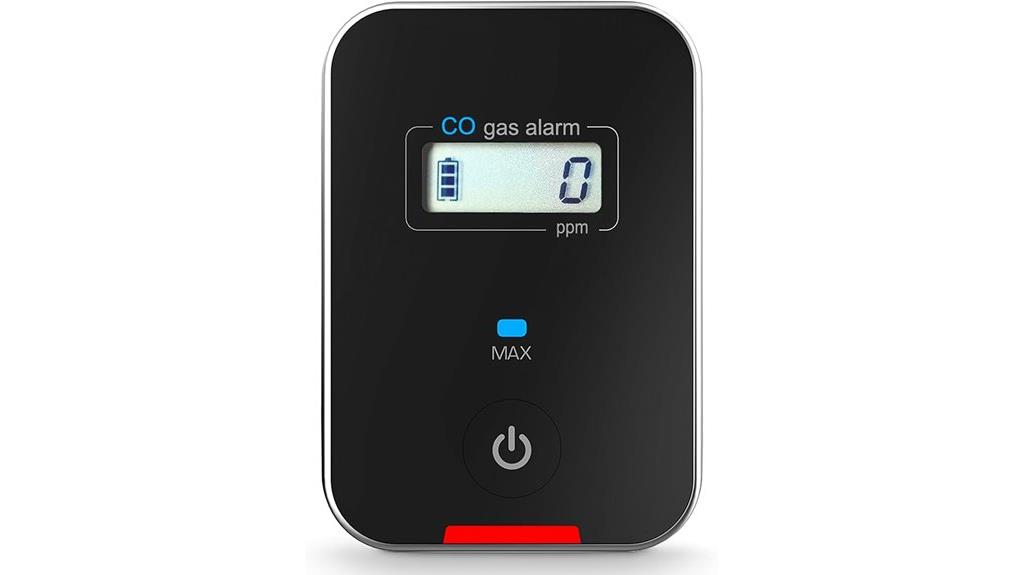
This car carbon monoxide detector stands out with its compact metal design and quick response alarm, making it an excellent choice for anyone concerned about exhaust leaks in vehicles or transportation environments. Weighing just 2 ounces, it’s easy to mount with a simple 3M adhesive, perfect for cars, buses, aircraft, or trucks. It detects low CO levels at 9ppm and alarms within 60 seconds, surpassing typical home detectors. The bright red LED and buzzer activate at levels exceeding 9ppm, aligning with safety standards. With a long-lasting battery life of 8-12 months and factory calibration, it offers reliable, continuous protection for drivers, passengers, or crew members.
Best For: drivers, pilots, and transportation professionals seeking quick, reliable CO detection to ensure safety in vehicles, aircraft, buses, and trucks.
Pros:
- Detects low CO levels at 9ppm with fast alarm response within 60 seconds.
- Compact, lightweight design weighing only 2 ounces, easy to install with 3M adhesive.
- Long-lasting operation of 8-12 months on the same batteries with factory calibration for accurate readings.
Cons:
- Requires battery replacement after 8-12 months for continued use.
- Limited to vehicle and transit environments; not suitable for home or industrial use.
- No wireless connectivity features; purely standalone detection device.
Carbon Monoxide and Gas Detectors, 4-in-1 Plug-in CO & Natural Gas Detector with Temperature & Humidity Display
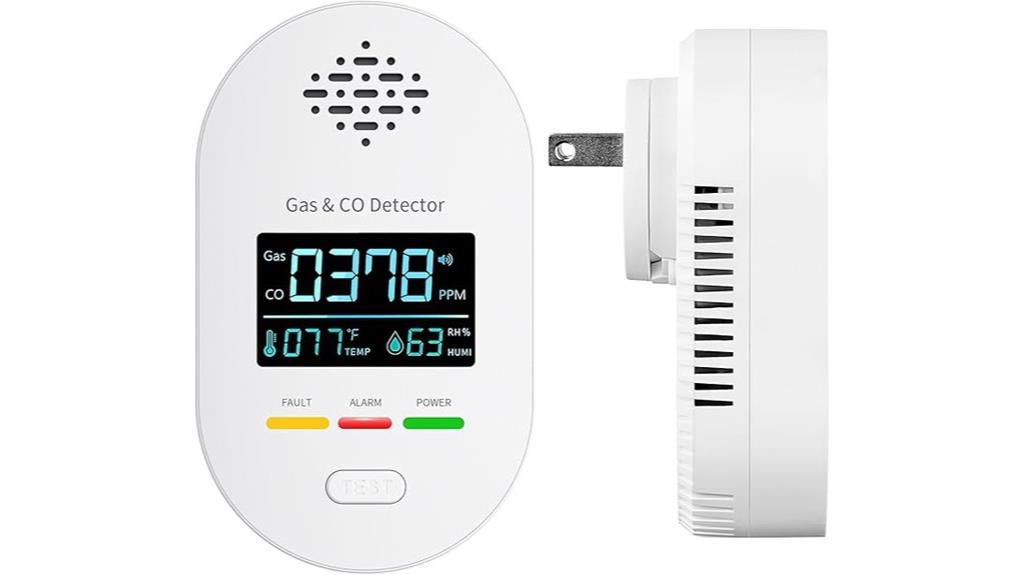
For schools seeking a reliable safety device, the 4-in-1 Plug-in CO & Natural Gas Detector with Temperature & Humidity Display stands out thanks to its real-time monitoring and clear digital readout. It provides continuous detection of carbon monoxide, natural gas, and other combustible gases, with instant alerts when levels become dangerous. Equipped with professional-grade sensors, it offers fast, accurate readings of gas concentrations, temperature, and humidity. The plug-in design makes it easy to install and operate in various spaces. This device ensures thorough safety by alerting staff to potential hazards, helping prevent dangerous leaks and maintaining ideal indoor air quality.
Best For: schools, homes, and enclosed spaces seeking reliable, real-time gas and CO detection with temperature and humidity monitoring.
Pros:
- Provides comprehensive 4-in-1 monitoring with digital display for easy reading
- Equipped with professional-grade sensors for fast, accurate detection of multiple gases and CO
- Easy plug-in installation suitable for various environments, ensuring continuous safety
Cons:
- May require regular calibration to maintain optimal sensor accuracy
- Audible alarm volume (85dB) could be too loud or too quiet depending on environment
- Limited to indoor use; not designed for outdoor safety monitoring
5-in-1 Carbon Monoxide, Gas, Smoke, CO Detectors with HD Display
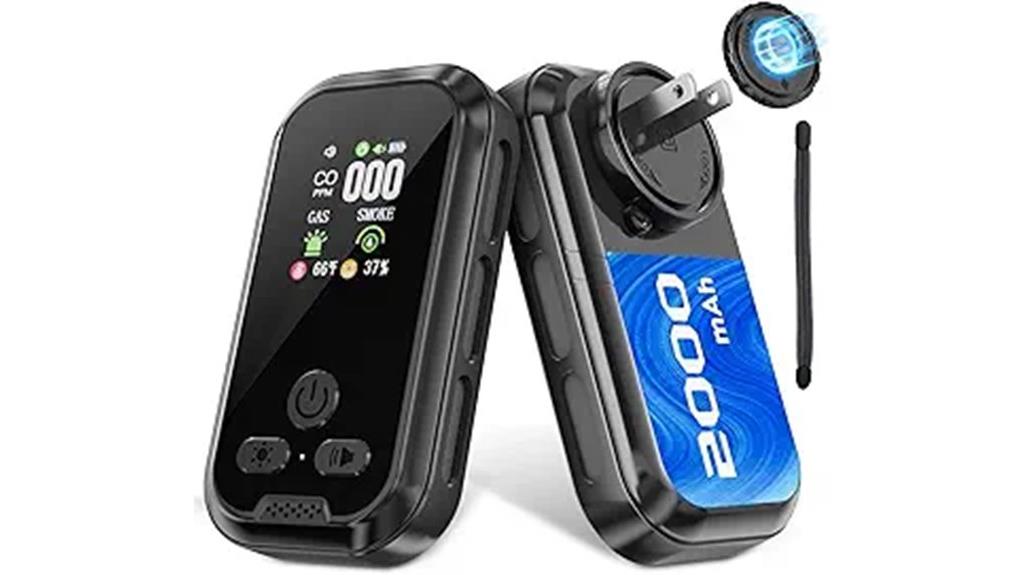
If you’re seeking a reliable safety device that combines multiple environmental sensors into a single, easy-to-read display, then the 5-in-1 Carbon Monoxide, Gas, Smoke, CO Detectors with HD Display is an excellent choice. It detects carbon monoxide, smoke, and combustible gases while providing real-time data on temperature and humidity. The HD display shows clear, immediate readings, helping you stay aware of indoor air quality. Its versatile design allows plugging into outlets or using as a portable device with a rechargeable battery. With a quick data refresh every 2 seconds and a powerful alarm system, it ensures prompt alerts for any danger, making it ideal for safeguarding schools.
Best For: homeowners, travelers, and RV owners seeking a comprehensive, easy-to-read safety device that monitors multiple environmental hazards simultaneously.
Pros:
- Combines detection of CO, smoke, gases, temperature, and humidity in one device for all-in-one safety monitoring
- HD digital display provides clear, real-time readings every 2 seconds for prompt awareness
- Versatile design allows use as a plug-in or portable device with a rechargeable battery, ensuring continuous protection
Cons:
- May require occasional calibration to maintain sensor accuracy over time
- The device’s multiple functions could be overwhelming for users unfamiliar with environmental monitoring technology
- Limited information on whether it integrates with smart home systems or external alert networks
8-in-1 Indoor Air Quality Monitor
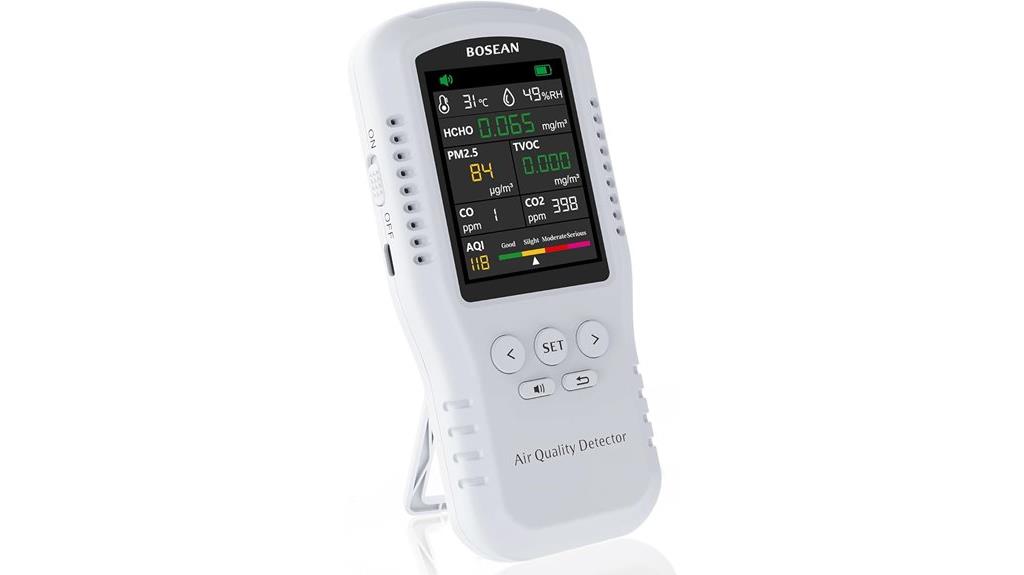
The in-1 Indoor Air Quality Monitor stands out as an ideal choice for schools that need a thorough and easy-to-use device to guarantee safe learning environments. It measures eight critical data points, including formaldehyde, CO, CO₂, TVOC, PM2.5, temperature, and humidity, providing extensive air quality insights. Its user-friendly LCD color screen clearly indicates pollution levels, while simple operation with a single button makes it accessible. Equipped with a rechargeable battery and alarms for safety thresholds, it’s perfect for various indoor spaces. To guarantee accurate readings, I recommend placing it in a ventilated environment for at least an hour before use.
Best For: Schools and educational institutions seeking an easy-to-use, comprehensive indoor air quality monitoring solution to ensure a safe learning environment.
Pros:
- Measures 8 critical air quality parameters for thorough monitoring
- User-friendly LCD color screen with clear pollution level indicators
- Built-in rechargeable battery with alarms for safety thresholds
Cons:
- Requires placement in a ventilated environment for at least 1 hour before use for accurate readings
- Limited battery life of 6-8 hours may require frequent charging
- Designed primarily for indoor use; less suitable for outdoor environments
Factors to Consider When Choosing a Combined CO₂ and VOC Detector for Schools
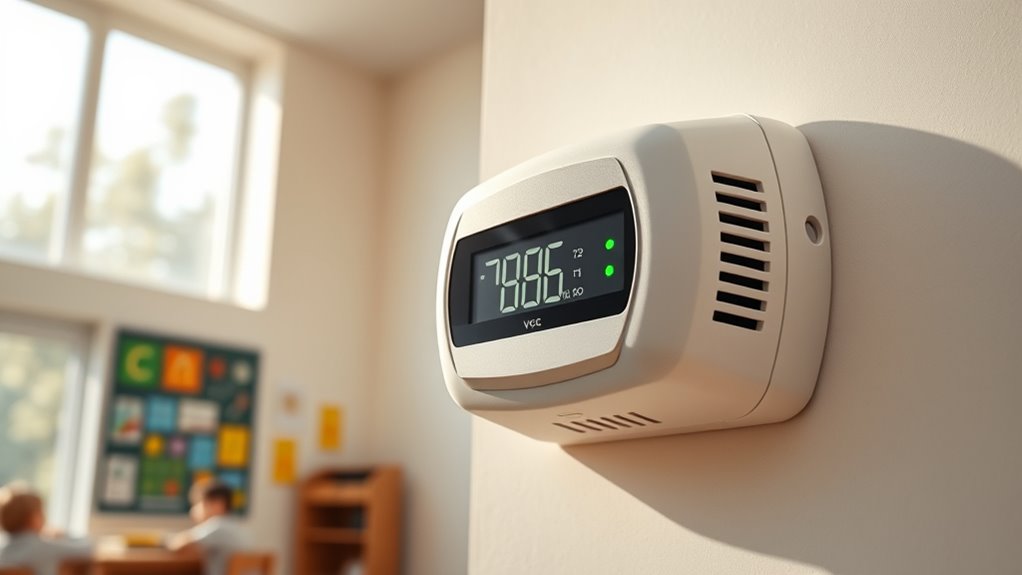
When choosing a combined CO₂ and VOC detector for schools, I look closely at measurement accuracy standards to guarantee reliable readings. I also consider sensor technology compatibility and how well the device displays real-time data, so I can quickly assess air quality. Finally, I evaluate the alert system’s effectiveness and battery life to ensure continuous, dependable monitoring.
Measurement Accuracy Standards
Choosing a combined CO₂ and VOC detector for schools hinges on understanding measurement accuracy standards, which directly impact the device’s reliability. Accurate readings are essential for identifying air quality issues and ensuring a safe environment. Typically, standards require sensors to be within ±1% or ±50 ppm of actual concentrations. Regulatory bodies like UL and EPA set acceptable accuracy ranges, guiding our choices. Maintaining accuracy over time depends on proper calibration protocols, including outdoor reference checks and periodic re-calibration. Advanced sensors, such as NDIR for CO₂ and photoionization or metal-oxide sensors for VOCs, generally provide higher accuracy. Consistent measurement accuracy ensures timely detection of hazardous conditions and compliance with health standards, making it a critical factor when selecting an air quality monitor for schools.
Sensor Technology Compatibility
Ensuring sensor technology compatibility is essential for accurately detecting multiple gases like CO₂ and VOCs in school environments. Different sensors, such as electrochemical for CO₂ and MOS for VOCs, must work seamlessly without interference. Compatibility involves aligning operational parameters like temperature ranges and response times to deliver reliable, simultaneous readings. Combining sensors also affects calibration; some require specific environments or correction algorithms to maintain accuracy over time. Proper compatibility reduces cross-sensitivity and false alarms, boosting overall reliability. When selecting a detector, consider whether the sensor technologies are designed to operate harmoniously within the device. This guarantees consistent performance, minimizes maintenance issues, and provides trusted data, all critical for maintaining safe, healthy learning environments.
Real-Time Data Display
A clear and responsive real-time data display is essential for effective use of CO₂ and VOC detectors in school settings. It provides immediate visibility of air quality levels, allowing staff to respond quickly to fluctuations. Accurate, real-time readouts help educators assess whether indoor environments meet safety standards without delay. Continuous updates enable monitoring of trends, making it easier to identify pollution sources or ventilation issues over time. High-resolution screens with color-coded indicators simplify interpretation, so staff can quickly understand air quality status at a glance. Many systems also feature alarm notifications when pollutant levels surpass safe thresholds, ensuring swift action. Overall, a user-friendly, real-time data display enhances safety by supporting prompt decision-making and ongoing air quality management in schools.
Alert System Effectiveness
When selecting a combined CO₂ and VOC detector for schools, the effectiveness of the alert system is essential for timely responses to air quality issues. An ideal system provides clear visual signals, like color-coded lights, and loud auditory alarms over 85 decibels, ensuring quick recognition. Audible alerts must activate instantly when pollutants exceed safe levels, prompting immediate action. Visual indicators should allow for quick assessment at a glance, helping staff respond swiftly. Customizable alarm thresholds are crucial to tailor sensitivity to specific environments or health needs. Additionally, a mute or silence function helps prevent alarm fatigue while maintaining safety. A reliable alert system balances prompt notifications with user control, ensuring occupants are alerted effectively without causing unnecessary disruptions.
Battery Life Reliability
Battery life plays a vital role in the reliability of combined CO₂ and VOC detectors for schools. A dependable device should last at least 20 hours to monitor air quality throughout the school day without needing frequent recharges. Short battery life, like 3-5 hours, can cause gaps in data and require constant attention, risking unnoticed air quality issues. Lithium-ion batteries with higher capacities, such as 1200mAh or more, tend to deliver longer operational periods, boosting reliability for daily use. Additionally, consistent battery performance over time, without rapid degradation, is essential for maintaining trust in the device. Opting for detectors with low power consumption and energy-saving modes can further extend battery life, reducing maintenance and ensuring continuous monitoring during school hours.
Ease of Calibration
Ease of calibration is essential for maintaining accurate and reliable air quality readings in school environments. Devices with automatic or simplified calibration processes save time and reduce user error, making them more practical for busy staff. Manual calibration often requires outdoor sensors or frequent adjustments, which can compromise data accuracy and increase maintenance efforts. User-friendly interfaces that guide calibration steps or perform self-calibration improve consistency and ease of use, ensuring staff can maintain the device without extensive technical knowledge. Additionally, stable calibration over time minimizes fluctuations in readings, providing more dependable data for health and safety decisions. When selecting a detector, prioritize models with straightforward calibration features to ensure ongoing accuracy and reliable monitoring of CO₂ and VOC levels in your school.
Device Portability Needs
Choosing a portable CO₂ and VOC detector for schools requires careful consideration of its size, weight, and durability. I look for devices that are lightweight and compact, making it easy to move between classrooms, labs, and common areas. Long battery life, ideally at least 20 hours, ensures continuous monitoring without frequent recharging, which is vital for busy school environments. Features like magnetic mounting or clip-ons allow quick installation and repositioning, saving time and effort. Durability is key—I prefer impact-resistant designs that can withstand frequent transport and accidental drops. Additionally, wireless connectivity and data logging capabilities are beneficial for remote monitoring and easy data retrieval across multiple locations. Overall, portability should combine convenience, reliability, and resilience to meet the dynamic needs of a school setting.
Cost and Maintenance
The cost and ongoing maintenance of combined CO₂ and VOC detectors substantially impact a school’s budget and long-term usability. Initial prices vary from around $50 for basic models to over $200 for more advanced units, affecting purchasing decisions. Regular calibration and sensor replacements are essential to ensure accurate readings, adding ongoing expenses. Many detectors need periodic cleaning of sensors and filters to prevent dust buildup, which can impair function. Some models feature rechargeable batteries, reducing replacement costs but requiring periodic charging and potential battery swaps. It’s also important to contemplate the availability and costs of replacement parts and calibration services, as these factors influence the device’s long-term affordability and reliability. Balancing initial costs with maintenance needs is key to choosing a cost-effective solution.
Frequently Asked Questions
How Often Should Co₂ and VOC Detectors Be Calibrated in Schools?
You’re wondering how often CO₂ and VOC detectors should be calibrated in schools. I recommend calibrating these devices at least once every six months to guarantee accuracy, but if they’re used frequently or in high-traffic areas, monthly checks might be better. Regular calibration helps maintain reliable readings, so I suggest setting reminders and following the manufacturer’s guidelines for specific calibration intervals.
What Is the Ideal Placement Height for These Detectors in Classrooms?
Perfect placement prevents pollution problems! I recommend installing CO₂ and VOC detectors at about eye level, roughly 3 to 5 feet from the ground. This height guarantees the devices accurately sense the air students breathe and teachers teach in. Avoid placing them near windows, doors, or vents where airflow can skew readings. Proper positioning helps maintain a healthy, harmonious, and hazard-free learning environment.
Are There Any Maintenance Requirements for Long-Term Sensor Accuracy?
Regarding maintenance for long-term sensor accuracy, I recommend regularly calibrating the detectors as specified by the manufacturer, usually annually. It’s also essential to keep the sensors clean and free from dust or debris, which can affect readings. Checking for firmware updates and replacing batteries when needed helps help guarantee continued performance. Consistent maintenance like this keeps the detectors dependable, providing accurate data to maintain a safe learning environment.
How Do Detectors Differentiate Between Harmful and Harmless VOCS?
When it comes to differentiating between harmful and harmless VOCs, detectors rely on advanced sensor technology and algorithms. I’ve found that many modern devices analyze the specific chemical signatures of VOCs, distinguishing dangerous ones from benign odors. They often use multiple sensors or filters to identify and prioritize harmful substances, helping us guarantee safety without false alarms. This technology makes it easier to maintain a healthy environment, especially in sensitive spaces like schools.
What Are the Power Source Options for Continuous Operation in Schools?
Imagine a lighthouse guiding ships safely through fog—that’s what reliable power sources do for detectors in schools. I recommend plugging detectors into AC outlets for continuous power, ensuring they run nonstop. Battery backups are great for emergencies or areas without outlets, and some detectors even feature rechargeable batteries. Combining these options guarantees constant protection, much like a lighthouse’s unwavering beam, keeping students safe and environments healthy.
Conclusion
Think of these detectors as vigilant guardians, silently patrolling the halls like watchful sentinels in a fortress. They stand guard, alerting us to unseen threats lurking in the air, much like a lighthouse guiding ships safely through treacherous waters. By choosing the right combination, we guarantee our learning environment stays a sanctuary—secure, healthy, and bright with knowledge—trusting these modern sentinels to protect what matters most: our children’s well-being and future.
